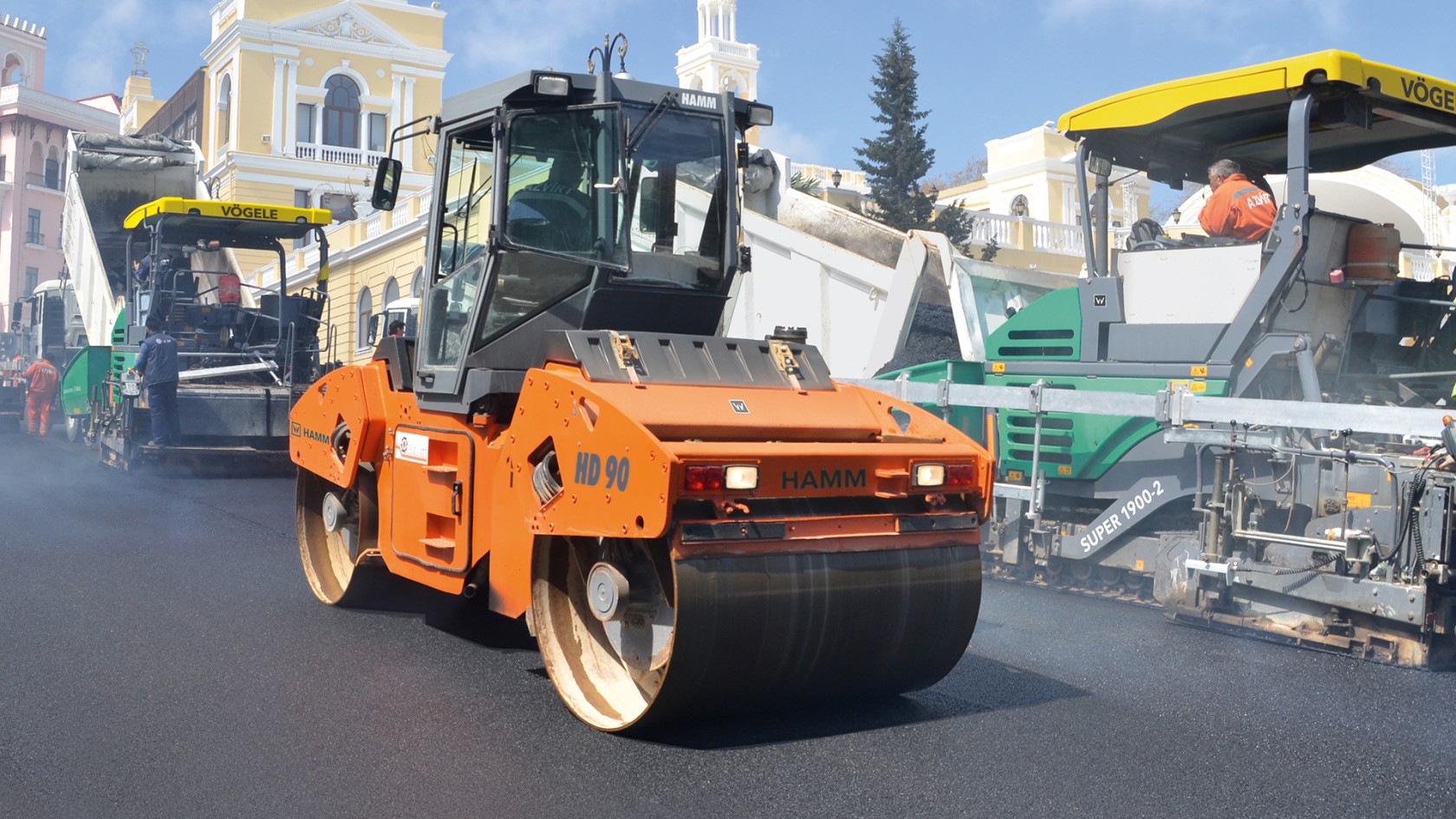

Formula 1 circuit in Baku: Hamm rollers refine demanding street circuit
In 2016, the Formula 1 once again broke new ground: For the first time, a race was held in Baku, the capital of Azerbaijan. Instead of building a new track somewhere in the open countryside, the German circuit planner Hermann Tilke, who had already planned the track in Shanghai in 2004, designed a demanding street circuit with 20 curves, a double chicane and an uphill section. The route leads past centuries-old buildings in the historical city centre, modern skyscrapers and the port on the Caspian Sea. So that the 22 racers can move their fast cars appropriately, machines from WIRTGEN, VÖGELE and HAMM have produced a high-quality asphalt layer in the narrow streets and on the wide boulevards.
Months before the race in Baku, preparations were already in full swing. Specifically for the Grand Prix, all facilities were constructed in the city itself, such as paddock including pit buildings, premises for the teams, a media centre, the medical centre and the grandstand. But undoubtedly the largest project was the asphalt paving for the 6.003 metre long track. The team of the Azerbaijani general contractor AzVirt LLC paved binder and surface courses over 113,000 m². The highest requirements of pavement quality were applicable, as the FIA, the organiser of the race, does not compromise on this point. After all, the Formula 1 cars reach speeds of over 350 km/h at full throttle, at the end of the round and on a less than 2-kilometre-long straight. And in such cases one thing is critical. Even if you roar along a street circuit, the asphalt must be homogeneous, level and have excellent grip.
From cobblestone pavement to high-speed track
And exactly here lay the challenge, as at the beginning of the year Baku still featured normal, paved city streets, some of them quite a few years old, as well as historic cobblestone pavement. To make the track race-ready, large WIRTGEN milling machines were used, equipped with fine milling tools and 3D control, to create a surface with a defined profile, to the highest standard of precision. Along the old city walls, however, this was impossible. This is where centuries-old cobblestone pavement is to be found, which should be left undamaged by the race as it forms part of UNESCO world cultural heritage. For this purpose, the internationally renowned asphalt consultant Dr Rainer Hart developed a special solution including carbon-reinforced asphalt.
Hot-on-hot sevenfold
The paving of the binder and surface courses was done in possibly record-breaking time, as AzVirt had an impressive armada of VÖGELE pavers and HAMM rollers at the start. The absolute highlight was the hot-on-hot installation in the area immediately in front of the beach promenade: There, seven of the eight SUPER 1900-2 pavers and 15 Hamm tandem rollers built a 52 metre wide area in a single operation. A real highlight for all participants!
HD, HD+ and HD CompactLine for high-quality compaction
To obtain optimum surface quality, AzVirt relied exclusively on tandem rollers from HAMM during compaction. The articulated machines of the HD, HD+ and HD CompactLine series ensure, through their very construction, even weight distribution – an important prerequisite for high evenness without ridges and cracks. Another important advantage of HAMM rollers is their excellent visibility. The large rollers of the HD+ series primarily stand out for their panoramic cabin. The machines of the HD CompactLine come with a "wasp-waist" front frame that provides an optimum overview of the working area. Last but not least, the HAMM rollers score points with their outstanding side clearance. In Baku, it enabled high-quality compaction along the many kerbs, fixtures and walls, right to the edge. In the process, the drivers also appreciated the large track offset of the articulated rollers that made it easy to achieve precise compaction of the edges.
Oscillation protects historic buildings
Another decisive factor for the high-quality compaction was the use of rollers with oscillation. This technology involves dynamic compaction that directs only few vibrations into the ground around the roller. That was crucial here, because the track is lined with many historic buildings and below the carriageway there are underground car parks and subways. Therefore, in most areas, conventional compaction with vibration was absolutely forbidden. "Instead, the paving plan required HAMM rollers with oscillation," explains asphalt specialist Hart, adding that "Everything has remained intact and, at the same time, we have achieved excellent compaction results." In Baku there was one more reason for oscillation compaction: The special movement of the oscillation drum produces very flat surfaces, with good initial skid resistance. Also thanks to this technology, AzVirt was able to meet the extremely high levelness requirements of 3 mm on a 4 metre long straight edge.
The best city streets in the world
The final quality check revealed that on the originally inhomogeneous city streets, a first-rate pavement has been laid. "Accordingly, thanks to the Formula 1 race, Baku currently has, without doubt, the best city streets in the world," as Dr Rainer Hart comments, with deep satisfaction, on the result of the paving work after it had been accepted by the FIA.